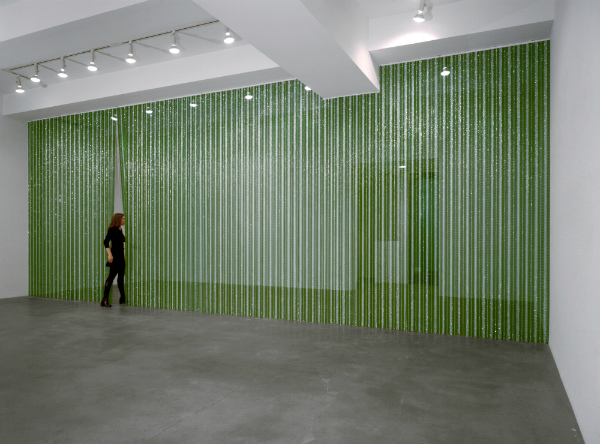
Hauser & Wirth’s vast main London space has never looked larger, or more mournful. One in a series of three Felix Gonzalez-Torres exhibitions being held this summer in New York, London, and Milan, curators Julie Ault and Roni Horn have reimagined this gallery as a cenotaph.
There are works here, though they are spare and restrained, and a re-positioning of the gallery’s internal wall serves to isolate them further. While Gonzalez-Torres drew on and subverted the formal language of Minimalism, here the controlled, repetitive forms of the works feel like a withdrawal or a signal to absence. All are drawn from 1991, a year that commenced for Gonzalez-Torres with the death of his partner Ross Laycock.
Felix Gonzalez-Torres, “Untitled” (Wawannaisa (1991) at Hauser & Wirth. Image ©The Felix Gonzalez-Torres Foundation Courtesy of Andrea Rosen Gallery, New York.
Entering the gallery, one is met by a white wall dressed with the plain blue mirror work “Untitled” (Fear). Reflections in the glass feel diminished, viewed through a mournful veil of color that renders the skin sickly. This act of imperfect (or transformative) mirroring offers the show its structure. Beyond the mirror, the main exhibition space is formed of two pairs of walls each meeting at a right angle. The left and right walls are hung with a sequence of small oblong puzzle works, all in washed out greys and grey-blues, echoing the bloodless color of skin as reflected in the blue mirror.
Two white electrical cables twine up the back wall, descending to a nuzzling pair of incandescent lightbulbs. The light work faces a pair of mirrors, “Untitled” (Orpheus, Twice), each scaled to reflect a standing human form. An explicit reference to the glass membrane of the Underworld in Jean Cocteau’s Orphée (1950), the vision of the afterlife these mirrors afford is altogether earthly. You see yourself present in the exhibition space, but only in one mirror at a time—the other mirror is empty, and thus the “picture” they present is incomplete.
The Orpheus mirrors are reproduced in the Milan exhibition at Massimo de Carlo—the only artwork that appears twice across the three venues and a formidable reminder of the importance of physical presence and the participatory role of the audience in Gonzalez-Torres’s work. It is perhaps a point worth underscoring in these shows, since Ault and Horn have steered away from the more crowd-pleasing “consumable” works (offerings of posters and mounds of sweets) that linger in the memory from the Serpentine Gallery exhibition of 2000.
Felix Gonzalez-Torres, “Untitled” (Last Letter) (1991). Image ©The Felix Gonzalez-Torres Foundation Courtesy of Andrea Rosen Gallery, New York
Wrapped neatly in plastic bags and balancing on white-tipped pushpins, the puzzles themselves are arranged in an echoing sequence on opposite walls: newspaper cutting, handwritten message, typed love letter, photograph. Love, death, and intimacy are the threads that bind them. Each is cropped just a little too close, so the content of the images is incomplete and no given limit is evident.
Both the handwritten “Untitled” (Lover’s Letter) and “Untitled” (Last Letters) carry fragments of Salome’s monologue by Oscar Wilde: “There was nothing in the world so black as thy hair. In the whole world there was nothing so red as thy mouth. Thy voice was a censer that scattered strange perfumes, and when I looked on thee I heard strange music.” Note the past tense—this is an address to the dead, though the handwriting, as we see from his signature on the puzzle “Untitled” (Last Letter) is Laycock’s.
Three of the puzzles show prints of newspaper clippings that relate to David Souter, a Supreme Court judge appointed by George H.W. Bush in 1990. Other clippings are from a New York Times article from June 11, 1991 describing the return of troops to New York at the end of the first Gulf War. Interspersed with these are puzzles showing Laycock with his dog Harry, or excerpts from intimate, loving correspondence. The personal and the political, then, sit side-by-side: emblematic of an era when, for a person with Aids, the personal was very political indeed.
Felix Gonzalez-Torres, “Untitled” (Vancouver) (1991). Image ©The Felix Gonzalez-Torres Foundation Courtesy of Andrea Rosen Gallery, New York
The stuff of the museum giftshop and a medium for the reproduction of popular paintings, the puzzle carries with it symbolism of a composite whole or fractured self. There is a lingering threat of destruction that comes with the loss of one small piece, as well as associations of play and of understanding, of seeing the whole picture. Each puzzle, in turn, shows a fragment of an object (a scrap of a letter, for example). Shown together in this way, there is also a suggestion that the grouped fragments offer a bigger picture.
In 1991 Andrea Rosen Gallery in New York presented a month-long Gonzalez-Torres exhibition “Every Week There is Something Different” in which, true to the title, the artwork switched each week. “Untitled” (Natural History), which occupied the gallery in the opening week, offered other individual fragments of a whole: thirteen black-and-white photographs each of one carved word from the Theodore Roosevelt Memorial. That series of fragments, like the puzzles, was itself part of a greater whole: the four-part exhibition.
Felix Gonzalez-Torres, “Untitled” (1989). Installation view, Wiels Contemporary Art Centre, Brussels, Belgium, 2010. Image ©The Felix Gonzalez-Torres Foundation Courtesy of Andrea Rosen Gallery, New York
While their curatorial statement is gnomic, one imagines Julie Ault (who worked with the Gonzalez-Torres as part of Group Materials) and Roni Horn (who was a close friend and artistic fellow spirit) to have been inspired by “Every Week” in approaching this new series of exhibitions, held 20 years after the artist’s death. They echo Gonzalez-Torres’s audacious approach to space, and look to the relation between fragment and whole—each puzzle a part of some larger truth, each exhibition a component in a bigger picture, all speaking of independence and interdependence, disintegration but also continuation.
Felix Gonzalez-Torres is on view at Hauser & Wirth, London until July 30.